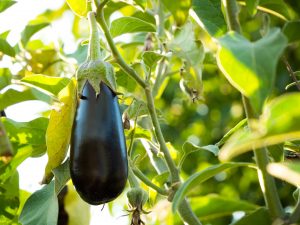Brinjal is in the Solanaceae family and is a typical tropical vegetable grown in India and globally throughout the year. Eggplant, garden egg, badanekai, vankaya, baingan, aubergine, and vangi are some famous names of Brinjal. Pests, diseases, and pathogens create hindrances in brinjal farming.
Brinjal cultivation is low-maintenance and usually requires 26° during the day and 18° at night, preferably high temperature for high yield. Calcium, phosphorus, and iron are common nutrients in every variety of brinjal cultivation. Crop rotation, vermicompost, manure, and biological pest control are the techniques of organic brinjal cultivation.
Let’s read about other aspects of brinjal cultivation.
Table of Contents
FAQs
- What is the brinjal yield per acre?
- Name organic pesticide for brinjal cultivation.
- Name some varieties of Brinjal.

Climate and soil requirement
Prolonged warm weather is ideal for Brinjal cultivation. A good amount of water and complete sunlight is the top requirement of brinjal cultivation. A temperature between 13-21° is suitable. Well-drained soil alongside organic matter is preferred. The best time to sow the brinjal crop is between rainy-summer seasons. Sandy and clayey soil produce early and high yields in brinjal.
Maintain the pH of around 6.5-7.5 of soil mixed with organic matter.
Planting procedure
The brinjal seeds are sown in the nursery bed to raise seedlings for transplanting in the field. The soil is left to get warm for 8-12 weeks and get over the last frost for a better yield of the next crop.
In sandy soil, flatbeds are sown with seeds, and raised beds are prepared to avoid water logging in heavy mud. The distance between two beds for watering and air circulation must be 70 cm, and 7.2 x 1.2m & 10-15 cm height is the ideal measurement for raised beds for brinjal cultivation. Drench the soil with bavistin at 2 gm/litre of water.
transplant the seedlings 2-3 feet apart in a double row or set them 18-24 inches away from the raised beds. Black plastic mulch is used to warm the soil in long springs. During the farming season, mix organic matter every two weeks in the ground.
Cover the soil with dry straw and sugarcane grass to maintain moisture and temperature. Transplanting within 4-6 weeks produces a good yield.
Irrigation requirement
For a fuller development of brinjal hybrid varieties, optimum water supply is the priority in brinjal cultivation. In summer, irrigation in 3-4 days and 7-12 days in winter is preferred. Do not irrigate excess in the early stage.
Otherwise, the damping-off disease will attack and damage.
Optimize the available water through drip irrigation. Avoid under-watering and over-watering. Keep it moist. Irrigation is a crucial aspect of high-yielding brinjal.
Harvesting of Brinjal

The brinjal harvest starts after attaining full size and color and before the ripening phase. Check the firmness of the vegetable; if it’s tender and glossy, harvesting is done. Don’t pull the Brinjal directly; use garden scissors for harvest. The glossy finish, dense color, and perfect size are signs of the optimum time to harvest the brinjal.
FAQs
Q1. What is the brinjal yield per acre?
– The brinjal yield per acre depends on various factors like the season, location, and hybrid seeds. A change in any one of the factors changes the yield. But the expected yield is 200-300 quintals per hectare.
Q2. Name some varieties of Brinjal.
– Pusa purple long or round or cluster, Azad Kranti, Arak Keshav or harshitha or shirsha or kusumkar or Navneet or Nidhi, Punjabi Bahar, and many more.
Note: The information contained herein is for informational purposes only. Nothing herein shall be construed to be financial or legal advice. Pesticides are a considerable risk of loss in crops and viewers are advised to do their own research before making any decisions.





